Biological Activity of Horehound (Marrubium vulgare L.) Herb Grown in Poland and Its Phytochemical Composition
Abstract
:1. Introduction
2. Results and Discussion
2.1. Chemical Composition of Essential Oil
2.2. Phytochemical Constituents of Extract
2.3. Antioxidant Activity of Extract
2.4. Antimicrobial Activity of Extract
2.5. Cell Viability Assay
3. Materials and Methods
3.1. Chemicals
3.2. Plant Material
3.3. Essential Oil Separation and GC-MS Analysis
3.4. Extract Preparation
3.5. Total Polyphenol Content of Extract
3.6. Total Flavonoid Content of Extract
3.7. Total Phenolic Acid Content of Extract
3.8. Condensed Tannin Content of Extract
3.9. HPLC Analysis
3.10. DPPH Scavenging
3.11. Ferric Reducing Antioxidant Power (FRAP Assay)
3.12. Cell Culture
3.12.1. Cytotoxicity Analysis—Alamar Blue (AB) and Neutral Red (NR) Uptake Assays
3.12.2. Determination of Intracellular Level of Reactive Oxygen Species (ROS)
3.13. Evaluation of the Antimicrobial Activity of the Extracts
3.13.1. Test Microorganisms
3.13.2. Minimum Inhibitory Concentration (MIC)
3.13.3. Minimum Bactericidal/Fungicidal Concentration (MBC/MFC)
3.13.4. Inhibition of Biofilm Formation
3.14. Statistical Analysis
4. Conclusions
Supplementary Materials
Author Contributions
Funding
Institutional Review Board Statement
Informed Consent Statement
Data Availability Statement
Conflicts of Interest
References
- Michalak, M. Plant-Derived Antioxidants: Significance in Skin Health and the Ageing Process. Int. J. Mol. Sci. 2022, 23, 585. [Google Scholar] [CrossRef]
- Mssillou, I.; Agour, A.; Hamamouch, N.; Lyoussi, B.; Derwich, E. Chemical Composition and In Vitro Antioxidant and Antimicrobial Activities of Marrubium vulgare L. Sci. World J. 2021, 2021, 7011493. [Google Scholar] [CrossRef] [PubMed]
- Aćimović, M.; Jeremić, K.; Salaj, N.; Gavarić, N.; Kiprovski, B.; Sikora, V.; Zeremski, T. Marrubium vulgare L.: A Phytochemical and Pharmacological Overview. Molecules 2020, 25, 2898. [Google Scholar] [CrossRef]
- Hayat, J.; Akodad, M.; Moumen, A.; Baghour, M.; Skalli, A.; Ezrari, S.; Belmalha, S. Phytochemical screening, polyphenols, flavonoids and tannin content, antioxidant activities and FTIR characterization of Marrubium vulgare L. from 2 different localities of Northeast of Morocco. Heliyon 2020, 6, e05609. [Google Scholar] [CrossRef] [PubMed]
- Ullah, R.; Alqahtani, A.S. GC-MS Analysis, Heavy Metals, Biological, and Toxicological Evaluation of Reseda muricata and Marrubium vulgare Methanol Extracts. Evid.-Based Complement. Altern. Med. 2022, 2022, 2284328. [Google Scholar] [CrossRef]
- Lodhi, S.; Vadnere, G.P.; Sharma, V.K.; Usman, R. Marrubium vulgare L.: A review on phytochemical and pharmacological aspects. J. Intercult. Ethnopharmacol. 2017, 6, 429–452. [Google Scholar]
- Yabrir, B. Essential Oil of Marrubium vulgare: Chemical Composition and Biological Activities. A Review. Nat. Prod. Sci. 2019, 25, 81–91. [Google Scholar] [CrossRef]
- Demiroz Akbulut, T.; Aydin Kose, F.; Demirci, B.; Baykan, S. Chemical Profile and Cytotoxicity Evaluation of Aerial Parts of Marrubium vulgare L. From Different Locations in Turkey. Chem. Biodivers. 2023, 20, e202201188. [Google Scholar] [CrossRef]
- Zarai, Z.; Kadri, A.; Ben Chobba, I.; Ben Mansour, R.; Bekir, A.; Mejdoub, H.; Gharsallah, N. The in-vitro evaluation of antibacterial, antifungal and cytotoxic properties of Marrubium vulgare L. essential oil grown in Tunisia. Lipids Health Dis. 2011, 21, 161. [Google Scholar] [CrossRef]
- Rezgui, M.; Majdoub, N.; Mabrouk, B.; Baldisserotto, A.; Bino, A.; Kaab, L.B.B. Antioxidant and antifungal activities of marrubiin, extracts and essential oil from Marrubium vulgare L. against pathogenic dermatophyte strains. J. Mycol. Med. 2020, 30, 100927. [Google Scholar] [CrossRef]
- Zawiślak, G. The chemical composition of the essential oil of Marrubium vulgare L. from Poland. Farmacia 2012, 60, 287–292. [Google Scholar]
- Nagy, M.; Svajdlenka, E. Comparison of Essential Oils from Marrubium vulgare L. and M. peregrinum L. J. Essent. Oil Res. 1998, 10, 585–587. [Google Scholar] [CrossRef]
- Guedri Mkaddem, M.; Zrig, A.; Ben Abdallah, M.; Romdhane, M.; Okla, M.K.; Al-Hashimi, A.; Alwase, Y.A.; Hegab, M.Y.; Madany, M.M.Y.; Hassan, A.H.A.; et al. Variation of the Chemical Composition of Essential Oils and Total Phenols Content in Natural Populations of Marrubium vulgare L. Plants 2022, 11, 612. [Google Scholar] [CrossRef]
- Abadi, A.; Hassani, A. Chemical composition of Marrubium vulgare L. essential oil from Algeria. Int. Lett. Chem. Phys. Astron. 2013, 8, 210–214. [Google Scholar] [CrossRef]
- Martino, M.; Volpe, S.D.; Cavalloro, V.; Amri, B.; Been Kaab, L.B.; Marrubini, G.; Rossi, D.; Collina, S. The use of a microwave-assisted solvent extraction coupled with HPLC-UV/PAD to assess the quality of Marrubium vulgare L. (white horehound) herbal raw material. Phytochem. Anal. 2019, 30, 377–384. [Google Scholar] [PubMed]
- Wojdyło, A.; Oszmianski, J.; Czemerys, R. Antioxidant activity and phenolic compounds in 32 selected herbs. Food Chem. 2007, 105, 940–949. [Google Scholar] [CrossRef]
- Amri, B.; Martino, E.; Vitulo, F.; Corana, F.; Ben-Kaâb, L.B.; Rui, M.; Rossi, D.; Mori, M.; Rossi, S.; Collina, S. Marrubium vulgare L. Leave Extract: Phytochemical Composition, Antioxidant and Wound Healing Properties. Molecules 2017, 22, 1851. [Google Scholar] [CrossRef] [PubMed]
- Salaj, N.; Barjaktarović, J.; Kladar, N.; Gavarić, N.; Bozin, B. Bimedical potential of horehound extract (Marrubium vulgare, Lamiaceae). Med. Pregl. 2018, LXXI, 21–26. [Google Scholar] [CrossRef]
- Kabach, I.; Ben Mridi, R.; Bouchmaa, N.; Bouargalne, Y.; Zyad, A.; Nhiri, M. Phytochemical screening, antioxidant and cytotoxic activities of M. vulgare. Int. J. Pharm. Res. 2019, 11, 338–345. [Google Scholar]
- Aouadhi, C.; Ghazghazi, H.; Hasnaoui, B.; Maaroufi, A. Total phenolic content, antioxidant and antibacterial activities of Marrubium vulgare methanolic extract. Tun. J. Med. Plants Nat. Prod. 2014, 11, 37–79. [Google Scholar]
- Al-Zaban, M.; Naghmouchi, S.; AlHarbi, N.K. HPLC-Analysis, Biological Activities and Characterization of Action Mode of Saudi Marrubium vulgare against Foodborne Diseases Bacteria. Molecules 2021, 26, 5112. [Google Scholar] [CrossRef] [PubMed]
- Tlili, H.; Hanen, N.; Ben Arfa, A.; Neffati, M.; Boubakri, A.; Buonocore, D.; Dossena, M.; Verri, M.; Doria, E. Biochemical profile and in vitro biological activities of extracts from seven folk medicinal plants growing wild in southern Tunisia. PLoS ONE 2019, 14, e0213049. [Google Scholar] [CrossRef]
- Amessis-Ouchemoukh, N.; Abu-Reidah, I.M.; Quirantes-Piné, R.; Madani, K.; Segura-Carretero, A. Phytochemical profiling, in vitro evaluation of total phenolic contents and antioxidant properties of Marrubium vulgare (horehound) leaves of plants growing in Algeria. Ind. Crop. Prod. 2014, 61, 120–129. [Google Scholar]
- Gourich, A.A.; Touijer, H.; Drioiche, A.; Asbabou, A.; Remok, F.; Saidi, S.; Siddique, F.; Ailli, A.; Bourhia, M.; Salamatullah, A.M.; et al. Insight into biological activities of chemically characterized extract from Marrubium vulgare L. in vitro, in vivo and in silico approaches. Front. Chem. 2023, 11, 1238346. [Google Scholar] [CrossRef] [PubMed]
- Dias, M.C.; Pinto, D.C.G.A.; Silva, A.M.S. Plant Flavonoids: Chemical Characteristics and Biological Activity. Molecules 2021, 26, 5377. [Google Scholar] [CrossRef] [PubMed]
- Gülçin, I. Antioxidant activity of caffeic acid (3,4-dihydroxycinnamic acid). Toxicology 2006, 217, 213–220. [Google Scholar] [CrossRef] [PubMed]
- Genaro-Mattos, T.C.; Maurício, Â.Q.; Rettori, D.; Alonso, A.; Hermes-Lima, M. Antioxidant Activity of Caffeic Acid against Iron-Induced Free Radical Generation—A Chemical Approach. PLoS ONE 2015, 10, e0129963. [Google Scholar] [CrossRef] [PubMed]
- Srinivasan, M.; Sudheer, A.R.; Menon, V.P. Ferulic Acid: Therapeutic potential through its antioxidant property. J. Clin. Biochem. Nutr. 2007, 40, 92–100. [Google Scholar] [CrossRef] [PubMed]
- Zduńska, K.; Dana, A.; Kolodziejczak, A.; Rotsztejn, H. Antioxidant Properties of Ferulic Acid and Its Possible Application. Skin Pharmacol. Physiol. 2018, 31, 332–336. [Google Scholar] [CrossRef]
- Bernatoniene, J.; Kopustinskiene, D.M. The Role of Catechins in Cellular Responses to Oxidative Stress. Molecules 2018, 23, 965. [Google Scholar] [CrossRef]
- Xu, D.; Hu, M.J.; Wang, Y.Q.; Cui, Y.L. Antioxidant Activities of Quercetin and Its Complexes for Medicinal Application. Molecules 2019, 24, 1123. [Google Scholar] [CrossRef] [PubMed]
- Enogieru, A.B.; Haylett, W.; Hiss, D.C.; Bardien, S.; Ekpo, O.E. Rutin as a Potent Antioxidant: Implications for Neurodegenerative Disorders. Oxid. Med. Cell Longev. 2018, 2018, 6241017. [Google Scholar] [CrossRef]
- Quave, C.L.; Smeltzer, M. Anti-biofilm activity of Marrubium vulgare L. (Lamiaceae) extract on MRSA. Plant Med. 2009, 75, 96. [Google Scholar] [CrossRef]
- Dib, K.; Cherrah, Y.; Rida, S.; Filali-Maltouf, A.; Ennibi, O.K. In Vitro Antibacterial Activity of Myrtus communis L. and Marrubium vulgare L. Leaves against Aggregatibacter actinomycetemcomitans and Eikenella corrodens. Evid.-Based Complement. Alternat. Med. 2021, 2021, 8351332. [Google Scholar] [CrossRef] [PubMed]
- Masoodi, M.H.; Ahmed, B.; Zargar, I.M.; Khan, S.A.; Khan, S.; Singh, P. Antibacterial activity of whole plant extract of Marrubium vulgare. Afr. J. Biotechnol. 2021, 7, 86–87. [Google Scholar]
- Kanyonga, P.M.; Faouzi, M.A.; Meddah, B.; Mpona, M.; Essassi, E.M.; Cherrah, Y. Assessment of methanolic extract of Marrubium vulgare for anti-inflammatory, analgesic and antimicrobiologic activities. J. Chem. Pharm. Res. 2011, 3, 199–204. [Google Scholar]
- Zhao, A.; Sun, J.; Liu, Y. Understanding bacterial biofilms: From definition to treatment strategies. Front. Cell Infect. Microbiol. 2023, 13, 1137947. [Google Scholar] [CrossRef]
- Sun, M.; Deng, Y.; Cao, X.; Xiao, L.; Ding, Q.; Luo, F.; Huang, P.; Gao, Y.; Liu, M.; Zhao, H. Effects of Natural Polyphenols on Skin and Hair Health: A Review. Molecules 2022, 27, 7832. [Google Scholar] [CrossRef] [PubMed]
- Farhan, M. The Promising Role of Polyphenols in Skin Disorders. Molecules 2024, 29, 865. [Google Scholar] [CrossRef] [PubMed]
- Adams, R.P. Identification of Essential Oil Compounds by Gas Chromatography/Quadrupole Mass Spectroscopy; Allured: Carol Stream, IL, USA, 2001. [Google Scholar]
- Morteza-Semnani, K.; Saeedi, M.; Babanezhad, E. The Essential Oil Composition of Marrubium vulgare L. from Iran. J. Essent. Oil Res. 2008, 20, 488–490. [Google Scholar] [CrossRef]
- Hamedeyazdan, S.; Zarei, M.; Salem, A.; Asnaashari, S.; Fathiazad, F. Essential Oil of Two Iranian Horehound Species: Marrubium propinquum and Marrubium parviflorum. Pharm. Sci. 2017, 23, 143–149. [Google Scholar] [CrossRef]
- Agbor, G.A.; Vinson, J.A.; Donnelly, P.E. Folin-Ciocalteau Reagent for Polyphenolic Assay. Int. J. Food Sci. Nutr. Diet. 2014, 3, 147–156. [Google Scholar] [CrossRef]
- Kim, D.-O.; Jeong, S.W.; Lee, C.Y. Antioxidant capacity of phenolic phytochemicals from various cultivars of plums. Food Chem. 2003, 81, 321. [Google Scholar] [CrossRef]
- Jain, R.; Rao, B.; Tare, A.B. Comparative analysis of the spectrophotometry based total phenolic acid estimation methods. J. Anal. Chem. 2017, 72, 972–976. [Google Scholar] [CrossRef]
- Brand-Williams, W.; Cuvelier, M.E.; Berset, C. Use of a free radical method to evaluate antioxidant activity. LWT—Food Sci. Technol. 1995, 28, 25–30. [Google Scholar] [CrossRef]
- Benzie, I.F.F.; Strain, J.J. The Ferric Reducing Ability of Plasma (FRAP) as a Measure of “Antioxidant Power”: The FRAP Assay. Anal. Biochem. 1996, 239, 70–76. [Google Scholar] [CrossRef] [PubMed]
- Michalak, M.; Zagórska-Dziok, M.; Klimek-Szczykutowicz, M.; Szopa, A. Phenolic Profile and Comparison of the Antioxidant, Anti-Ageing, Anti-Inflammatory, and Protective Activities of Borago officinalis Extracts on Skin Cells. Molecules 2023, 28, 868. [Google Scholar] [CrossRef] [PubMed]
- CLSI. Methods for Dilution Antimicrobial Susceptibility Tests for Bacteria That Grow Aerobically; Approved Standard—Ninth Edition. CLSI document M07-A9; Clinical and Laboratory Standards Institute: Wayne, PA, USA, 2012. [Google Scholar]
- Merritt, J.H.; Kadouri, D.E.; O’Toole, G.A. Growing and analyzing static biofilms. Curr. Protoc. Microbiol. 2005, 22, 1B-1. [Google Scholar] [CrossRef]
- Shakya, S.; Danshiitsoodol, N.; Noda, M.; Inoue, Y.; Sugiyama, M. 3-Phenyllactic acid generated in medicinal plant extracts fermented with plant-derived lactic acid bacteria inhibits the biofilm synthesis of Aggregatibacter actinomycetemcomitans. Front. Microbiol. 2023, 13, 991144. [Google Scholar] [CrossRef]
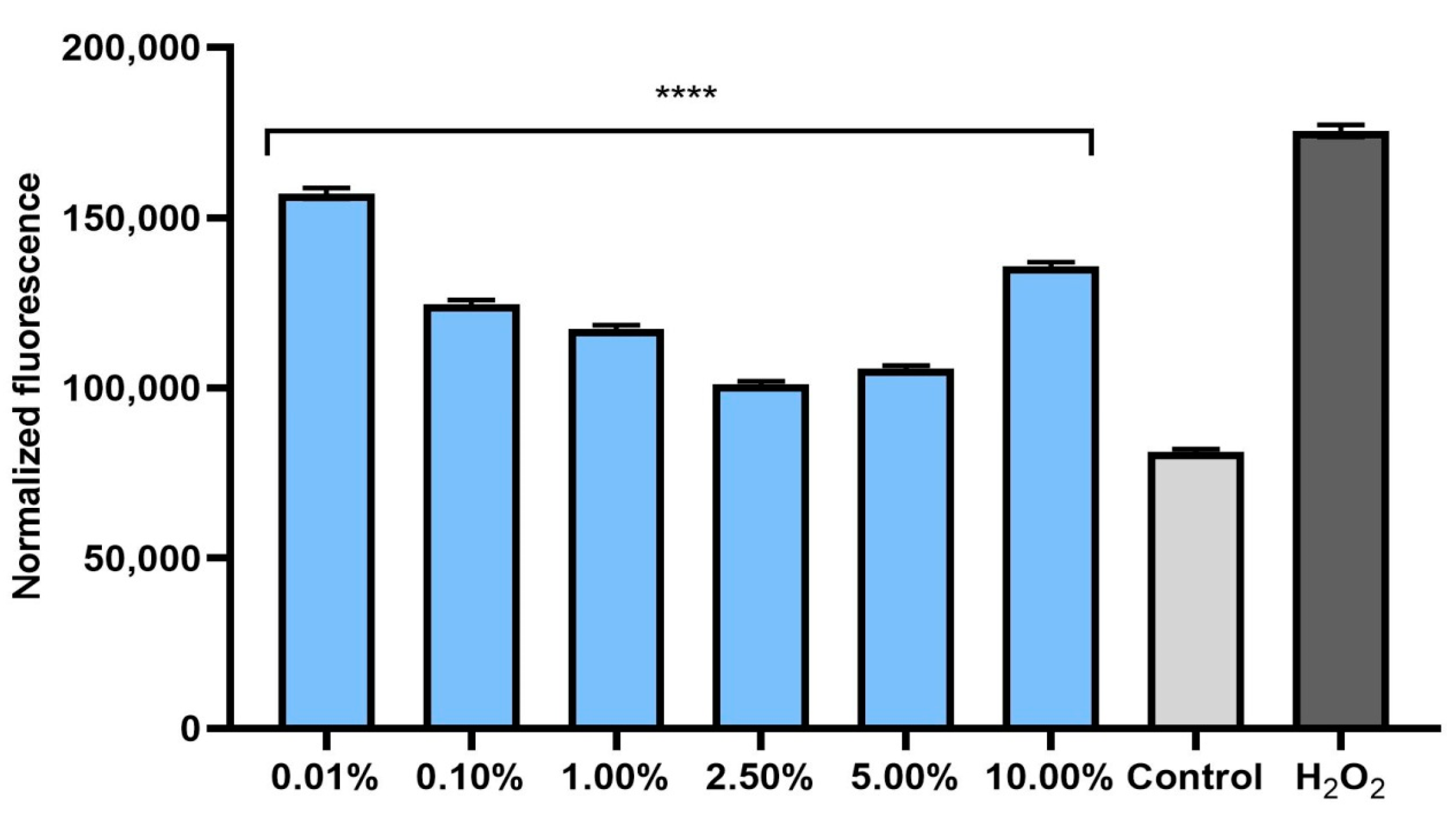
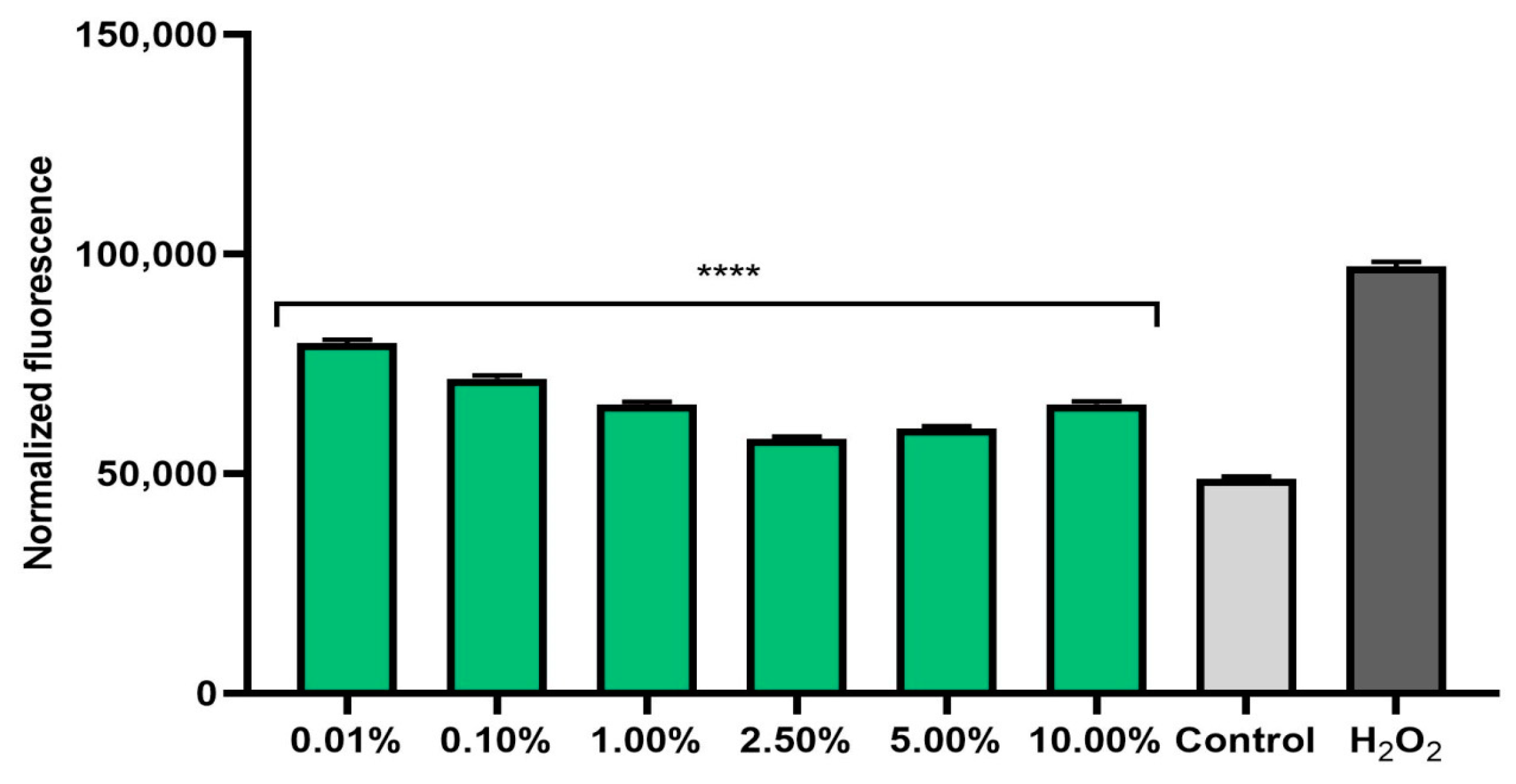

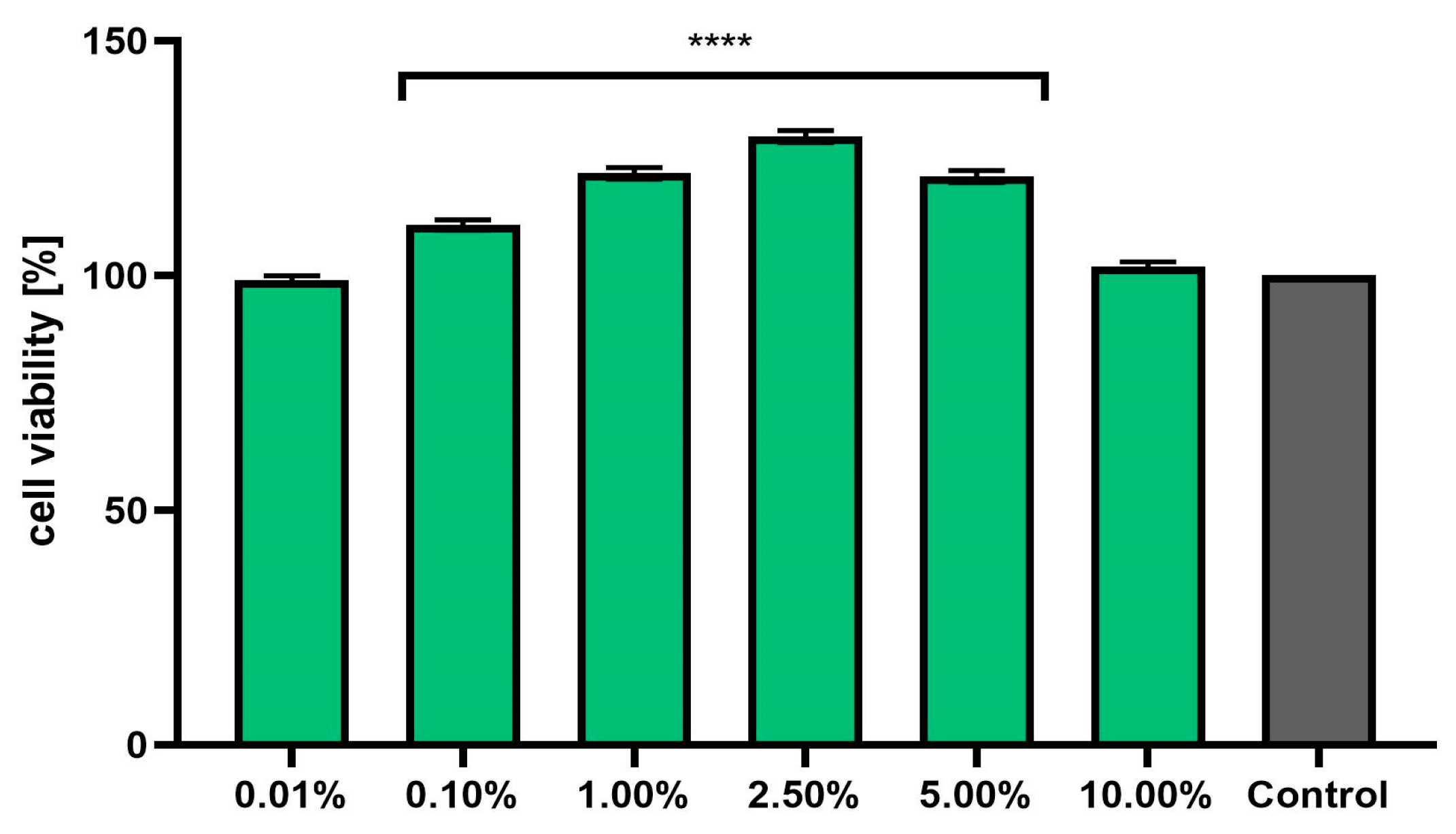
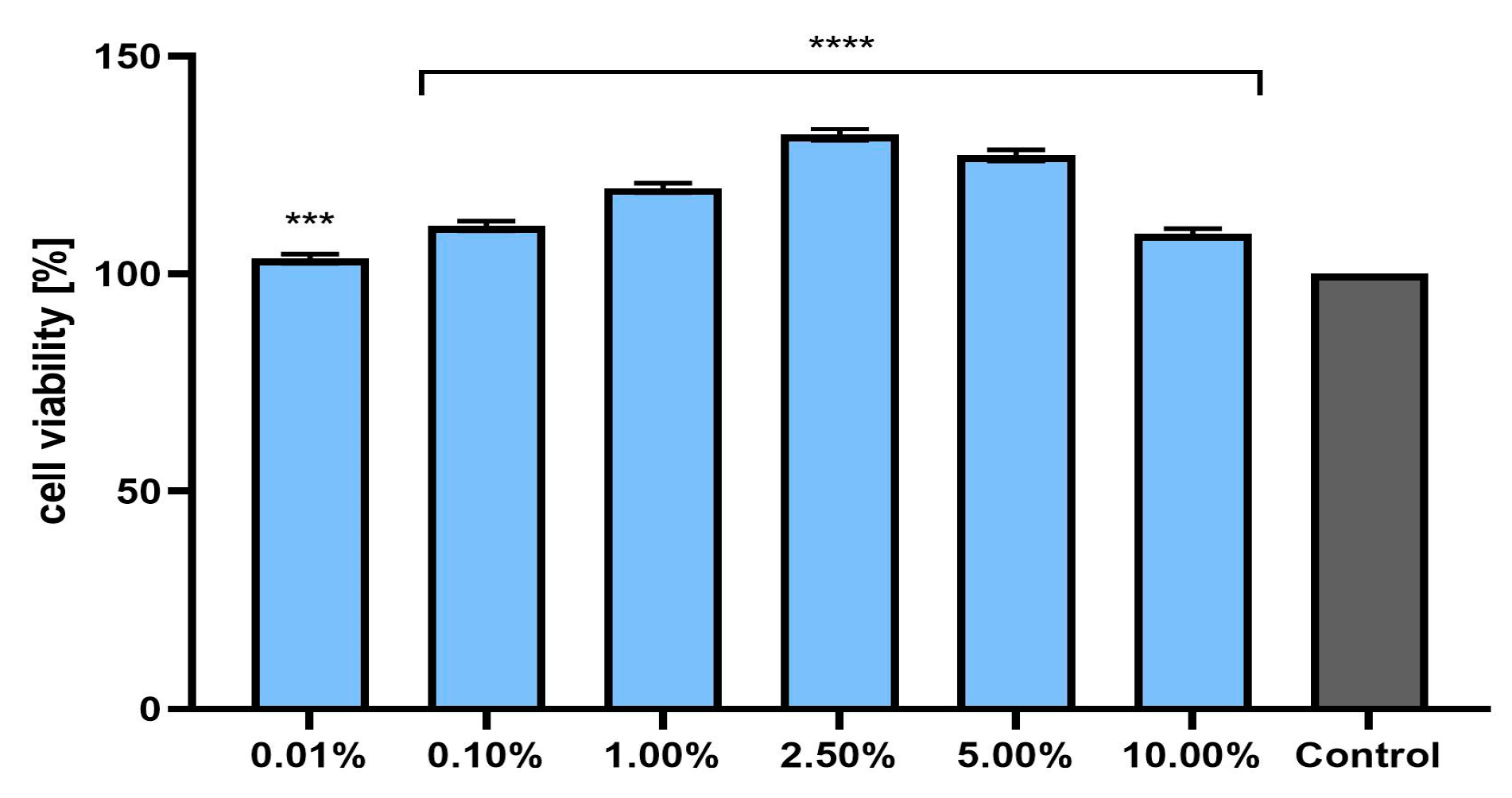
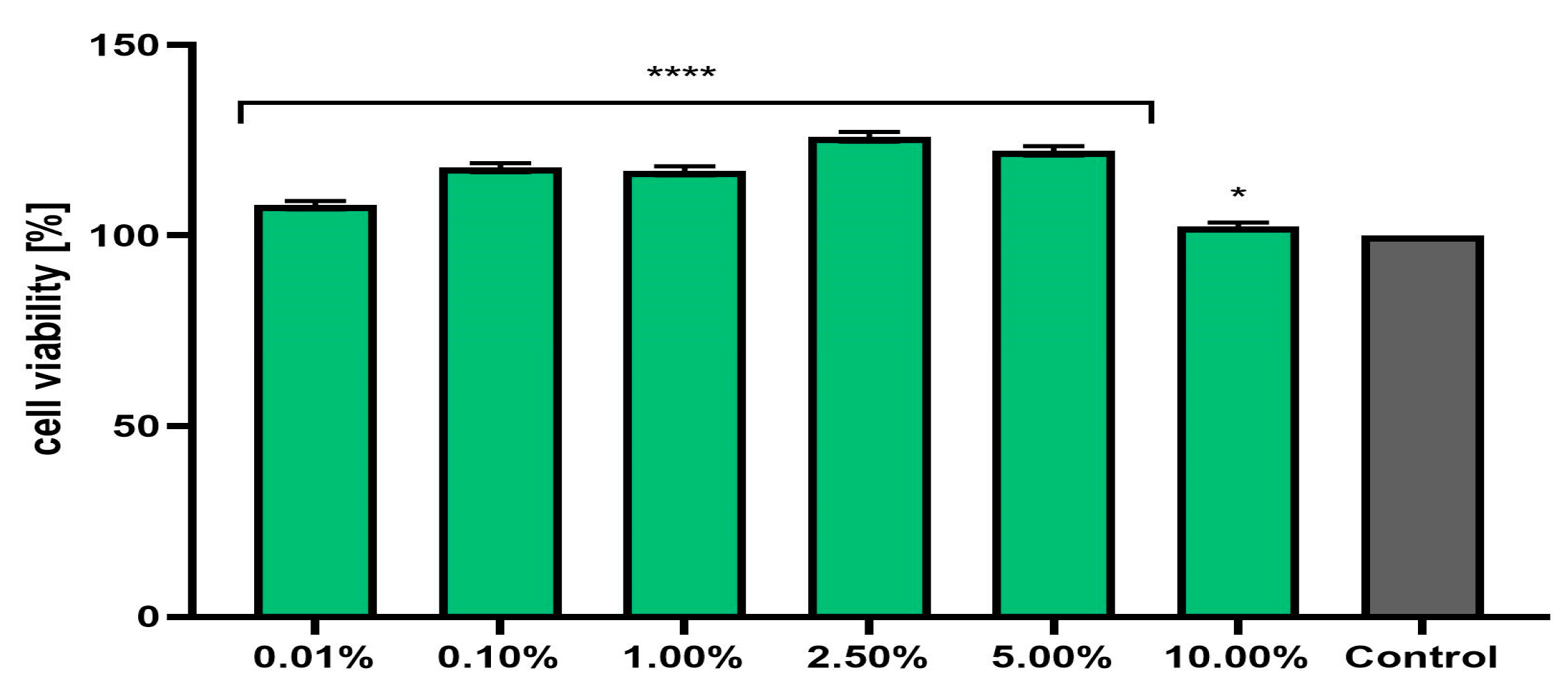
| Compound | RT a | RI b | % c |
|---|---|---|---|
| α-Thujene | 7.948 | 857 | 0.1 ± 0.00 |
| β-Pinene | 7.993 | 862 | 0.1± 0.00 |
| Limonene | 8.712 | 942 | 1.1 ± 0.03 |
| γ-terpinene | 9.772 | 1060 | 1.2 ± 0.03 |
| Geijerene | 10.508 | 1142 | 0.4 ± 0.02 |
| trans-Pinocamphone | 10.670 | 1160 | 0.1 ± 0.00 |
| cis-Pinocamphone | 10.796 | 1174 | 0.1± 0.00 |
| Thymol | 11.002 | 1197 | 0.5 ± 0.02 |
| Carvacrol | 11.065 | 1204 | 5.7 ± 0.06 |
| α-Copaene | 11.811 | 1287 | 1.9 ± 0.02 |
| β-Bourbonene | 11.910 | 1298 | 2.1 ± 0.03 |
| β-Elemene | 12.098 | 1319 | 1.3 ± 0.03 |
| E-Caryophyllene | 12.197 | 1330 | 35.7 ± 0.05 |
| β-Copaene | 12.260 | 1341 | 2.8 ± 0.04 |
| β-Gurjunene | 12.305 | 1342 | 0.1 ± 0.00 |
| (Z)-β-Farnesene | 12.529 | 1367 | 0.1 ± 0.00 |
| α-Humulene | 12.610 | 1376 | 0.1 ± 0.00 |
| Germacrene D | 12.691 | 1385 | 25.2 ± 0.06 |
| Viridiflorol | 12.754 | 1392 | 0.1 ± 0.00 |
| Bicyclogermacrene | 12.826 | 1400 | 10.6 ± 0.04 |
| γ-Cadinene | 12.988 | 1418 | 0.1 ± 0.00 |
| δ-Amorphene | 13.131 | 1434 | 7.2 ± 0.02 |
| α-Cadinene | 13.293 | 1452 | 0.1 ± 0.00 |
| β-Sesquiphellandrene | 13.832 | 1512 | 0.1 ± 0.00 |
| α-Cadinene | 14.066 | 1538 | 0.1 ± 0.00 |
| E-Nerolidol | 14.398 | 1575 | 0.1 ± 0.00 |
| Spathulenol | 14.497 | 1586 | 0.1 ± 0.00 |
| Caryophyllene oxide | 14.533 | 1590 | 0.1 ± 0.00 |
| Humulene epoxide II | 14.784 | 1618 | 0.1 ± 0.00 |
| epi-α-Muurolol | 14.910 | 1632 | 0.1 ± 0.00 |
| α-Cadinol | 15.054 | 1648 | 0.5 ± 0.00 |
| Total | 99.9 ± 0.15 | ||
| Monoterpene hydrocarbons | 2.9 ± 0.04 | ||
| Oxygenated monoterpenes | 6.4 ± 0.07 | ||
| Sesquiterpene hydrocarbons | 89.8 ± 0.12 | ||
| Oxygenated sesquiterpenes | 0.8 ± 0.05 | ||
| Total Polyphenols (mg GAE/mL ± SD) | Total Flavonoids (mg CE/mL ± SD) | Total Phenolic Acids (mg CAE/mL ± SD) | Condensed Tannins (mg DpE/mL ± SD) |
|---|---|---|---|
| 55.72 ± 0.06 | 11.01 ± 0.03 | 4.33 ± 0.03 | 4.46 ± 0.05 |
| Compound | Content (mg/mL ± SD) | |
|---|---|---|
| Phenolic acids | Caffeic acid | 0.67 ± 0.04 |
| Ferulic acid | 35.42 ± 0.07 | |
| Protocatechuic acid | 18.70 ± 0.02 | |
| p-Coumaric acid | 16.65 ± 0.04 | |
| Ellagic acid | 0.15 ± 0.00 | |
| Syringic acid | 12.69 ± 0.01 | |
| Flavonoids | Catechin | 24.69 ± 0.02 |
| Quercetin | 20.65 ± 0.03 | |
| Myricetin | 0.79 ± 0.01 | |
| Apigenin | 2.31 ± 0.01 | |
| Luteolin | 6.68 ± 0.02 | |
| Rutin | 14.46 ± 0.01 |
| Test Microorganism | Hydroethanolic Extract | Streptomycin/ Erythromycin | Fluconazole | |
|---|---|---|---|---|
| MIC | MBC/MFC | MIC | MIC | |
| Staphylococcus aureus | 4.0 ± 0.02 | 4.0 | 0.001 ± 0.005 | - |
| Staphylococcus epidermidis | 4.0 ± 0.04 | 4.0 | 0.062 ± 0.04 | - |
| Streptococcus agalactiae | 4.0 ± 0.01 | 4.0 | 0.001 ± 0.02 | - |
| Streptococcus mutans | 2.0 ± 0.03 | 2.0 | 0.004 ± 0.03 | - |
| Streptococcus pyogenes | 2.0 ± 0.12 | 2.0 | 0.001 ± 0.02 | - |
| Streptococcus pneumoniae | 4.0 ± 0.05 | 4.0 | 0.001 ± 0.02 | - |
| Enterococcus faecalis | 2.0 ± 0.002 | 2.0 | 0.004 ± 0.02 | - |
| Escherichia coli | 4.0 ± 0.05 | 4.0 | 0.015 ± 0.04 | - |
| Pseudomonas aeruginosa | 4.0 ± 0.08 | 4.0 | 0.015 ± 0.02 | - |
| Shigellasonnei | 4.0 ± 0.01 | 4.0 | 0.015 ± 0.02 | - |
| Proteus mirabilis | 2.0 ± 0.09 | 2.0 | 0.062 ± 0.07 | - |
| Candida albicans | 1.0 ± 0.14 | 1.0 | - | 0.001 ± 0.02 |
| Strain | Extract Concentration (mg/mL) | ||||||
|---|---|---|---|---|---|---|---|
| 0.25 | 0.5 | 1 | 2 | 4 | 8 | 16 | |
| Gram-positive bacteria | |||||||
| S. aureus | 17.7 ± 2.8 | 14.1 ± 0.9 | 30.8 ± 3.7 | 34.9 ± 1.6 | 49.2 ± 1.3 | 38.2 ± 2.0 | - |
| S. epidermidis | 4.4 ± 0.3 | - | - | - | - | - | - |
| S. agalactiae | - | - | - | - | 58.3 ± 0.9 | 51.8 ± 2.3 | - |
| S. mutans | - | - | - | - | 83.67 ± 0.6 | 80.57 ± 2.6 | 60.7 ± 2.1 |
| S. pyogenes | - | - | 17.1 ± 3.7 | 60.6 ± 3.2 | 72.5 ± 0.8 | 68.9 ± 2.1 | 27.8 ± 4.1 |
| S. pneumoniae | - | - | - | - | 64.9 ± 1.0 | 59.5 ± 2.6 | - |
| E. faecalis | - | - | 27.5 ± 4.0 | 42.7 ± 0.3 | 42.1 ± 1.0 | 42.9 ± 0.3 | - |
| Gram-negative bacteria | |||||||
| E. coli | 21.4 ± 0.7 | 32.0 ± 0.2 | 38.29 ± 1.2 | 31.5 ± 1.0 | 42.6 ± 1.2 | 58.7 ± 1.1 | - |
| P. aeruginosa | - | - | - | 47.5 ± 2.2 | 66.0 ± 5.0 | 81.3 ± 1.7 | 57.9 ± 2.7 |
| S.sonnei | 27.5 ± 0.7 | 18.5 ± 1.7 | 29.3 ± 1.3 | 26.4 ± 0.3 | 13.6 ± 1.8 | 1.4 ± 4.0 | - |
| P. mirabilis | - | 19.3 ± 2.4 | 48.2 ± 1.2 | 38.2 ± 1.7 | 60.4 ± 5.1 | 65.2 ± 2.8 | 31.1 ± 2.0 |
| Fungal strain | |||||||
| C. albicans | - | 53.0 ± 0.6 | 57.1 ± 2.4 | 67.3 ± 0.7 | 65.5 ± 0.8 | 64.0 ± 1.8 | 23.7 ± 1.8 |
| Bacterial Strains | |
|---|---|
| Gram-Positive | Gram-Negative |
| Staphylococcus aureus PCM 2054 | Pseudomonas aeruginosa PAO1 |
| Staphylococcus epidermidis PCM 2118 | Escherichia coli PCM 2057 |
| Streptococcus agalactiae PCM 2683 | Proteus mirabilis S1959 |
| Streptococcus pyogenes PCM 2855 | Shigella sonnei PCM 2336 |
| Streptococcus mutans PCM 2502 | |
| Streptococcus pneumoniae PCM 2589 | |
| Enterococcus faecalis PCM 2673 | |
| Fungal strains | |
| Candida albicans ATTC 10231 | |
Disclaimer/Publisher’s Note: The statements, opinions and data contained in all publications are solely those of the individual author(s) and contributor(s) and not of MDPI and/or the editor(s). MDPI and/or the editor(s) disclaim responsibility for any injury to people or property resulting from any ideas, methods, instructions or products referred to in the content. |
© 2024 by the authors. Licensee MDPI, Basel, Switzerland. This article is an open access article distributed under the terms and conditions of the Creative Commons Attribution (CC BY) license (https://creativecommons.org/licenses/by/4.0/).
Share and Cite
Michalak, M.; Stryjecka, M.; Zagórska-Dziok, M.; Żarnowiec, P. Biological Activity of Horehound (Marrubium vulgare L.) Herb Grown in Poland and Its Phytochemical Composition. Pharmaceuticals 2024, 17, 780. https://doi.org/10.3390/ph17060780
Michalak M, Stryjecka M, Zagórska-Dziok M, Żarnowiec P. Biological Activity of Horehound (Marrubium vulgare L.) Herb Grown in Poland and Its Phytochemical Composition. Pharmaceuticals. 2024; 17(6):780. https://doi.org/10.3390/ph17060780
Chicago/Turabian StyleMichalak, Monika, Małgorzata Stryjecka, Martyna Zagórska-Dziok, and Paulina Żarnowiec. 2024. "Biological Activity of Horehound (Marrubium vulgare L.) Herb Grown in Poland and Its Phytochemical Composition" Pharmaceuticals 17, no. 6: 780. https://doi.org/10.3390/ph17060780





